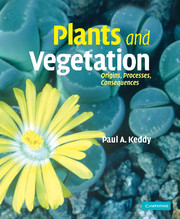Book contents
- Frontmatter
- Contents
- Preface
- Acknowledgements
- Chapter 1 Plants and the origin of the biosphere
- Chapter 2 Description of vegetation: the search for global patterns
- Chapter 3 Resources
- Chapter 4 Stress
- Chapter 5 Competition
- Chapter 6 Disturbance
- Chapter 7 Herbivory
- Chapter 8 Positive interactions: mutualism, commensalism, and symbiosis
- Chapter 9 Time
- Chapter 10 Gradients and plant communities: description at local scales
- Chapter 11 Diversity
- Chapter 12 Conservation and management
- Questions for Review
- References
- Index
- References
Chapter 1 - Plants and the origin of the biosphere
- Frontmatter
- Contents
- Preface
- Acknowledgements
- Chapter 1 Plants and the origin of the biosphere
- Chapter 2 Description of vegetation: the search for global patterns
- Chapter 3 Resources
- Chapter 4 Stress
- Chapter 5 Competition
- Chapter 6 Disturbance
- Chapter 7 Herbivory
- Chapter 8 Positive interactions: mutualism, commensalism, and symbiosis
- Chapter 9 Time
- Chapter 10 Gradients and plant communities: description at local scales
- Chapter 11 Diversity
- Chapter 12 Conservation and management
- Questions for Review
- References
- Index
- References
Summary
Energy flow and molecular complexity. Membranes. The serial endosymbiosis hypothesis for the origin of eukaryotes. Photosynthesis. The oxygen revolution. The ozone layer. Respiration. Multicellular life. Plant life moves onto land. Evolution and diversification of land plants. Plants, coal, and climate.
Introduction
Plants occur in almost every conceivable habitat on Earth – submerged on lake bottoms, exposed on wind-swept mountain tops, hidden within polar rocks, or perched perilously on branches in the rain forest canopy. They can be microscopic (oceanic plankton) or enormous like sequoias and eucalypts that may tower more than a hundred meters tall. Their flowers may span nearly a meter across (Rafflesia arnoldii) or extend the height of a human (Amorphophallus titanum), and be almost any color of the rainbow. Moreover, plants comprise more than 99 percent of all the Earth's living matter! We can also say with confidence that the history of the biosphere is largely the history of the origin and diversification of plants. Without plants, conditions on Earth – including temperature, types of rocks, the composition of the atmosphere, and even the chemical composition of the oceans – would be vastly different.
While plant ecology is generally defined as “the study of relationships between plants and the environment,” plants do not, as this definition implies, merely inhabit environments. Plants also modify the environments, and they may even control them. Where, then, should one begin a book on plant ecology?
- Type
- Chapter
- Information
- Plants and VegetationOrigins, Processes, Consequences, pp. 1 - 34Publisher: Cambridge University PressPrint publication year: 2007



